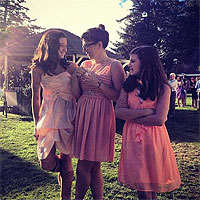 I'm not going to lie: I'm exhausted. In the last 4 weeks I have attended 3 weddings, 2 of which were in Oregon. In a usual year, I would make excuses about why I can't go to any weddings, let alone three: important readings, ethically I can't go to weddings until gay marriage is recognized at the federal level, whatever. But this year the weddings were for members of my family and very close friends and so I sucked it up and went. And I was pleasantly surprised.
I'm not going to lie: I'm exhausted. In the last 4 weeks I have attended 3 weddings, 2 of which were in Oregon. In a usual year, I would make excuses about why I can't go to any weddings, let alone three: important readings, ethically I can't go to weddings until gay marriage is recognized at the federal level, whatever. But this year the weddings were for members of my family and very close friends and so I sucked it up and went. And I was pleasantly surprised.
These events all followed the same basic format, sure, but they also all so specifically represented the couples getting married. They were sweet and fun and made me feel pretty happy, which got me thinking: today, weddings are basically, at their best, really successful performance art pieces, put on by people who usually don't even call themselves artists. If the goal of art is to transport the viewer/participant outside his/her daily life in a way that elevates some element of being human (and I am saying that is the goal of art), then weddings do that more satisfyingly than any performance piece in a gallery or on a sidewalk. Sure they are put on by amateurs who generally did not go to art school, but in some very important ways, these events succeed where frequently gallery performances fail. Here, my friends, is why:

1. They actually create an immersive environment.
Once you step into a wedding, whether it's at a church or outside on folding chairs, you know you are no longer in real life. Everything is controlled and planned: the music you hear, the flower arrangements you see and smell, the seats you sit on, the food and drinks you put into your mouth. Nothing is left to chance, except maybe the flower girls, but let's be honest, the flower girls are always meant as comic relief.


